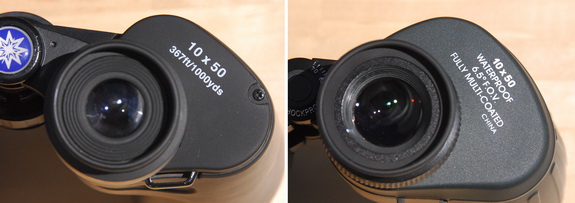
Choosing binoculars is easy once you understand the specs.
Shopping for binoculars at your local camera store or on-line can be a bewildering experience. And if stargazing is your goal, the task becomes even more confusing — there are so many factors to consider and so many (often contradictory) opinions about what matters and what doesn’t. Fortunately, once you understand some of the basic specifications, figuring out whether or not a given binocular is going to suit your needs becomes a lot easier.
Here is a break down of specifications, in order of decreasing importance:
1. Price. Okay, this isn’t a binocular specification really, but it is important. You’re not going to enjoy your new binoculars if you see dollar signs instead of stars every time you use them. So set a dollar limit and stick to it. You can get a functional pair for as little as $50 and something that’s essentially beyond reproach for a couple hundred. Above that, the sky’s the limit.
2. Magnification. Every binocular has at least two numbers stamped on its body next to one of the eyepieces. In the examples pictured here, notice the 10 × 50 designation. The magnification is the first number in that set. These binoculars magnify 10×, that is, they will make things appear ten times closer. In general, higher magnification means more detail in the image, no matter if you’re looking at a bird or a star cluster. But (and this is a big “but”) you can have too much of a good thing. If you’re hand-holding your binoculars (as opposed to using them on a tripod), you’ll probably find 10× is the upper limit. Higher magnification also means you’ll generally see a smaller circle of sky in your binoculars. All things considered, 10× binos provide the best balance between image detail and sky coverage.
3. Aperture. This is the second number in the 10 × 50 specification and it gives the diameter of the front lenses (called “objective lenses”) millimeters. Bigger lenses mean more light gathering. That’s a good thing. For stargazing, you’ll generally want binoculars with front lenses from 30mm to 75mm across. You can get models with even bigger lenses (so-called giant binoculars), but here again, hand holding is out of the question and a tripod becomes a must-have accessory.
4. F.O.V. Field Of View. This number tells you how much sky you will see in your binoculars. In this case, 6.5°. This is a handy piece of information, but most binoculars don’t provide it. And it’s a bit tough to visualize what this means unless you understand that sky distances are measured in degrees. So, from the horizon to the zenith (the point directly overhead) is 90° — these binoculars will show roughly 1/14th of that distance. Another way to visualize the field of these binoculars is to know that the width of your fist on your outstretched arm covers about 10°. A wide field of view is good — it makes it easier to find your targets and you can drink in more sky in a single view.
5. Ft/Yrds. This another way of stating the field of view of binoculars. In the example illustrated here (367ft/1000yrds) it simply means that if you’re looking at a building 1,000 yards away, you’d see 367 feet of its height and 367 feet of its width. (That’s a damn big building, but you get the idea.) To convert this number into something more astronomically useful, divide the first number by 52.4. These binoculars would yield a field of view of about 7° (367 divided by 52.4). If the specification is given in metric terms (“112 meters at 1,000 meters,” for example) simply divide the first number by 16 instead.
Those are the numbers you’re going to encounter, and now you know what they mean. The missing piece of the puzzle is how they all interrelate — and make no mistake about it, they do interrelate. To learn more about that, read Rating Binoculars.
Did you find this article interesting or helpful? If so, consider using this link the next time you shop at Amazon.com. Better yet, bookmark it for future use. Thanks to Amazon’s associates program, doing so costs you nothing yet helps keep this site up and running. Thanks!
